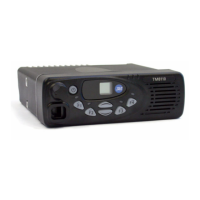TM8100/TM8200 Service Manual Interface Fault Finding 177
© Tait Electronics Limited June 2006
Task 2 —
Check Input Lines
For an input line suspected or reported to be faulty, proceed as follows:
1. For a suspect
CH ON OFF line, go to Step 4. For all other input lines go
to Step 2.
2. For the suspect line, apply a 3.3V DC test signal to a connector mated
to the radio connector in question.
3. Check the internal signal for the line under test. If 3.3V DC is
present, go to Step 7. If it is not, go to Step 8.
4. For the
CH ON OFF line, apply a short to ground on pin 5 of a connector
mated to the control-head connector. Check that there is 3.9V DC
present on the
ITF ON OFF line, and that PSU ON OFF is approximately
equal to the radio’s primary supply voltage, nominally 13.8V DC.
5. Remove the short on the connector. Check that, with
CH ON OFF
open-circuit, both
ITF ON OFF and ITF PSU ON OFF are close to 0.0V.
6. If the voltages given in Step 4 and Step 5 are observed, go to Step 7.
If they are not, go to Step 8.
7. The fault lies with the radio’s internal circuitry. If the power-supply
circuitry or the CODEC and audio circuitry is suspect, continue with
the fault diagnosis as in “Power Supply Fault Finding” on page 163
and “CODEC and Audio Fault Finding” on page 381, respectively.
If the digital board is suspect, replace the board and go to “Final
Tasks” on page 157.
8. The fault lies in the filtering, basic processing, or connector for the
line under test. Re-solder components or replace faulty components
as necessary. Confirm the removal of the fault and go to “Final Tasks”
on page 157. If the fault could not be found, replace the board and
go to “Final Tasks” on page 157.
Task 3 —
Bi-directional Lines
For a bi-directional line suspected or reported to be faulty, proceed as
described below. In the procedure the direction of the line will need to be
configured. For information on this topic consult the on-line help facility
on the programming application’s “Programmable I/O” page.
1. Configure the suspect line as an output, and then carry out the
procedure given in Tas k 1
.
2. Configure the suspect line as an input, and then carry out the
procedure given in Tas k 2
.

